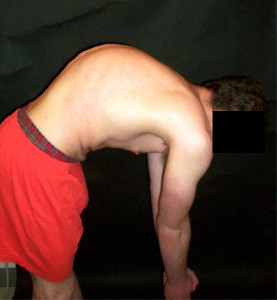 Often in yoga classes words with a normal connotation take on abnormal meanings.
Often in yoga classes words with a normal connotation take on abnormal meanings.
Kyphosis is a common one as is lordosis.
Kyphosis, a rounding of the upper back, and lordosis, a curving of the lower back and neck, are both part of the normal makeup of the spine.
They can each reach a degree of exaggeration that turns them into a condition that needs attention.
Kyphosis as a problem usually refers to an exaggerated rounding of the upper back often referred to as a hunchback for men and a dowager’s hump in older women.
There is a range of curve that is considered a normal kyphosis (20-40 degrees), and when the curvature begins to pass 45 degrees it is considered abnormal.
An abnormal kyphosis can occur anywhere along the spine but is most often seen in the upper thoracic area where it is naturally rounded already.
Everyone’s spine is slightly rounded as it runs up the back. The thoracic spine—any part of the spine with a rib attached—rounds naturally at a gentle angle.
My upper back is very broad and before I developed my lipoma that was recently removed I often thought I was on the way towards a hunchback.
Back in the day when I was a waiter (25 years ago) I had miserable posture and found it painful to stand up straight and extend my spine.
The only thing that I can attribute to the extension that I am able to find now is the core tone that I have built over the last fifteen years of yoga and exercise.
It is still easy to see the remnants of my almost extreme kyphosis because I still slump plenty but changing my walk and posture has had a large impact on the alignment and appearance of the spine.
***
